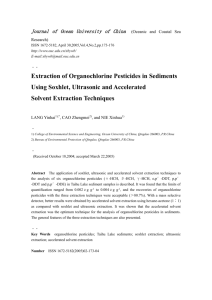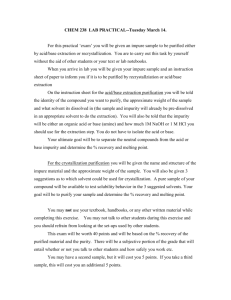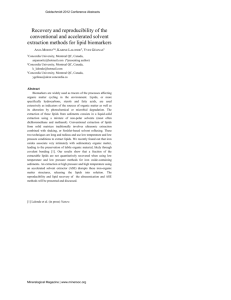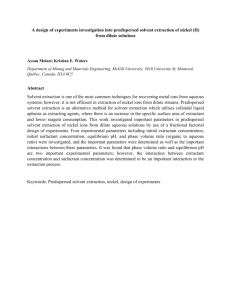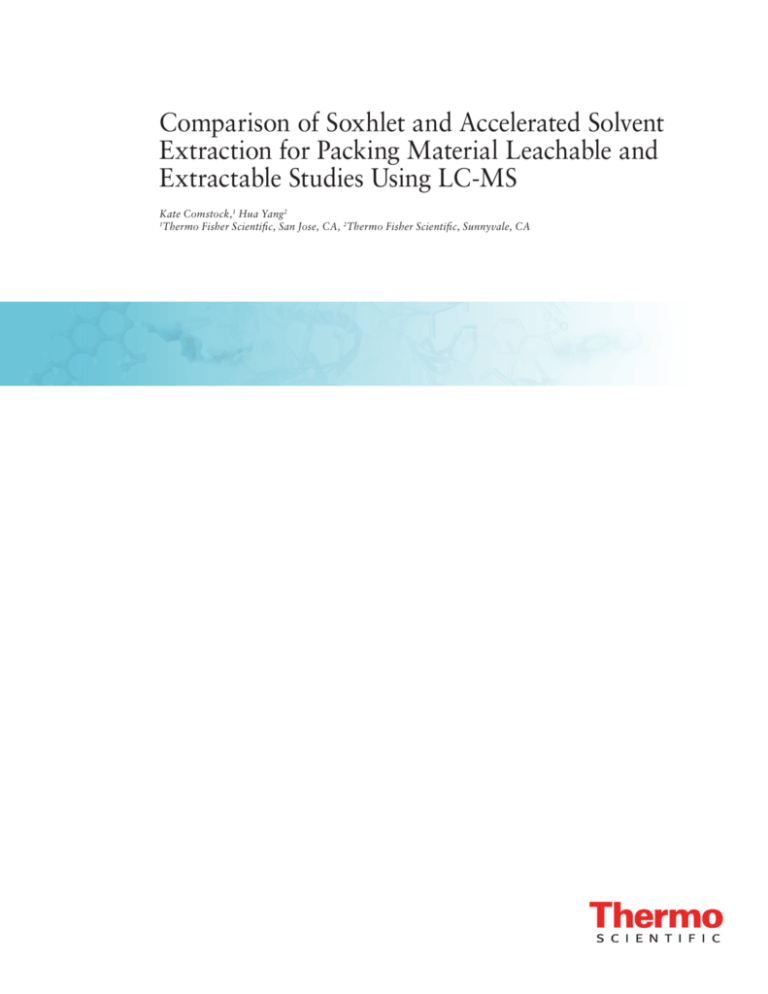
Comparison of Soxhlet and Accelerated Solvent
Extraction for Packing Material Leachable and
Extractable Studies Using LC-MS
Kate Comstock,1 Hua Yang2
1
Thermo Fisher Scientific, San Jose, CA, 2Thermo Fisher Scientific, Sunnyvale, CA
Overview
Purpose: To compare Soxhlet and accelerated solvent extraction (ASE) techniques for
leachable and extractable analysis.
Methods: A transdermal patch pouch and a polypropylene pill bottle were extracted
with 2-propanol and hexane using both the Thermo Scientific™ Dionex™ ASE™ 350
Accelerated Solvent Extractor system and Soxhlet. The samples were analyzed by an
LC-MS system consisting of a Thermo Scientific™ UltiMate 3000 LC system and a
Thermo Scientific™ Q Exactive™ Quadrupole-Orbitrap Mass Spectrometer.
Results: Compared to Soxhlet, the Dionex ASE 350 system produces equivalent or
more efficient extraction results, but with less time (<0.5 vs. 24 h per sample) and
reduced organic solvent use (<30 vs. 160 mL per sample), thereby saving money and
time.
Introduction
.
According to the regulations and guidelines of the U.S. Food and Drug Administration
(US FDA) 1, the European Medicines Agency (EMA), and other regulatory agencies,
extractable and leachable information must be included in each application: New Drug
Application (NDA), Abbreviated New Drug Application (ANDA) and Biologics License
Application (BLA) for medical devices and container closure systems packaging human
drugs and biologics.
The main purposes of determining extractable are to obtain data for risk assessment
and to provide a basis for leachable studies. Determining what extent compounds can
be extracted establishes the maximum amount of material that could be leached.
Therefore, sample extraction is an important first step for a successful extractable and
leachable study.
Methods
Sample Preparation
Two packaging material sam
local pharmacy and a transd
company, were extracted us
apparatus (n = 1) with 2-pro
cut into ~ 2 mm2 to increase
efficiency.
Accelerated solvent extracti
Dionex ASE extraction cell t
.extraction cell filled with sam
new glass filter in each extra
volume with clean Ottawa sa
cell cap. Figure 3 shows an
extraction cells were placed
lower. Accelerated solvent e
precision, weigh each collec
extraction, divide the sample
FIGURE 2. Filled Dionex A
Extraction Cell
Extraction Flow
Extractions traditionally have been carried out using the Soxhlet or reflux techniques2
which require a lengthy extraction (>24 h/sample) and consume a large quantity of
solvent (>150 mL/sample). Accelerated solvent extraction technique is an automated
extraction technique which provides many advantages over traditional methods. One
advantage of using a Dionex ASE 350 system is that up to 24 samples and three
solvents can be processed unattended following a single setup. Figure 1 shows a
schematic of the accelerated solvent extraction technique.
O
S
S
The accelerated solvent extraction technique employs pressure so that organic
solvents can be used at temperatures above their boiling points to deliver extractions
equivalent to or even better than traditional techniques, but at greatly reduced
extraction time (<0.5 hr/sample) and solvent use (<30 mL/sample). ASE has been
shown to be a powerful technique to reliably extract compounds from polymer
materials.3
In this study, accelerated solvent extraction technique is compared to Soxhlet
extraction for the analysis of extractable from packaging material.
FIGURE 1. Schematic of the Accelerated Solvent Extraction Technique
TABLE 1. Accelerated So
Extraction solvent
Extraction cell size (mL)
Temperature (C)
Static extraction time (min)
Number of static cycles
Rinsing volume (%)
Purge time (Sec)
Total solvent volume per sa
Total extraction time per sa
Soxhlet: Add 160 mL solven
about 20 min. Weigh and re
start extraction and extract f
solution by weight after extra
After extraction, transfer 1 m
.
2 Comparison of Soxhlet and Accelerated Solvent Extraction for Packing Material Leachable and Extractable Studies Using LC-MS
.
ne pill bottle were extracted
ntific™ Dionex™ ASE™ 350
samples were analyzed by an
ate 3000 LC system and a
Mass Spectrometer.
tem produces equivalent or
vs. 24 h per sample) and
e), thereby saving money and
ood and Drug Administration
other regulatory agencies,
n each application: New Drug
NDA) and Biologics License
ure systems packaging human
ain data for risk assessment
g what extent compounds can
al that could be leached.
a successful extractable and
Sample Preparation
Two packaging material samples, an amber polypropylene pill bottle purchased from a
local pharmacy and a transdermal patch pouch obtained from a pharmaceutical
company, were extracted using the Dionex ASE 350 system (n = 3) and Soxhlet
apparatus (n = 1) with 2-propanol and hexane. Prior to extraction, both samples were
cut into ~ 2 mm2 to increase surface area of the sample and therefore the extraction
efficiency.
Accelerated solvent extraction: Pack ~ 0.5 g of sample into each Thermo Scientific
Dionex ASE extraction cell to carry out extraction. Figure 2 illustrates an Dionex ASE
.extraction cell filled with sample. To prepare an Dionex ASE extraction cell, place a
new glass filter in each extraction cell cap, weigh sample into Dionex ASE cell, fill void
volume with clean Ottawa sand (Fisher Scientific Cat # S23-3) and hand tighten the
cell cap. Figure 3 shows an Dionex ASE 350 system, in which filled Dionex ASE
extraction cells were placed into the upper carousel and the collection vials in the
lower. Accelerated solvent extraction conditions are listed in Table 1. For the best
precision, weigh each collection vial without the cap and septum before and after
extraction, divide the sample weight by solvent density to determine the volume.
FIGURE 3 Dionex ASE 350 System
FIGURE 2. Filled Dionex ASE
Extraction Cell
Liquid Chromatography
Column:
Thermo Scientific
2.1 × 100mm, 2.6
Mobile phase: A: Water /0.1% F
Gradient :
5% B( 0 – 3 min)
Flow Rate:
0.4 mL/min
Inj. Volume: 10 µL
Column Temp.:30°C
Detection: Q Exactive mass spe
with a HESI-II probe (Sheath Ga
was acquired at full scan (m/z 1
dependent MS/MS at 15,000 re
Data Analysis
Thermo Scientific™ Dionex™ C
software and Thermo Scientific™
Results and Disc
Prior to running sample extracti
Soxhlet system blanks were col
the systems. Figure 4 shows the
chromatograms of HPLC , 2-pro
identical, with three major peaks
both Dionex ASE 350 and Soxh
FIGURE 4. Chromatograms of 2
Extraction Flow
Soxhlet or reflux techniques2
onsume a large quantity of
n technique is an automated
ver traditional methods. One
to 24 samples and three
setup. Figure 1 shows a
e.
Ottawa
Sand
2.0e9
Sample
essure so that organic
points to deliver extractions
but at greatly reduced
L/sample). ASE has been
pounds from polymer
Intensity (counts)
extraction (ASE) techniques for
Methods
Glass
Fiber
Filter
HPLC Blank
1.0e9
2-propanol Sol
2-propanol Sox
0.0e0
compared to Soxhlet
material.
TABLE 1. Accelerated Solvent Extraction Conditions
2-propanol
Method
Hexane Method
2-propanol
Hexane
Extraction cell size (mL)
10
10
Temperature (C)
Extraction solvent
125
100
Static extraction time (min)
5
10
Number of static cycles
3
2
Rinsing volume (%)
100
100
Purge time (Sec)
120
120
Total solvent volume per sample (mL):
~28
~25
Total extraction time per sample (min):
20
25
Soxhlet: Add 160 mL solvent to flask. Set up the Soxhlet apparatus with cycle time
about 20 min. Weigh and record sample weight (0.5 to 1.0 g) into glass fiber thimble;
start extraction and extract for 24 hours. Determine the final volume of the extract
solution by weight after extraction is completed.
After extraction, transfer 1 mL of the extract into an HPLC vial for HPLC/MS analysis.
.
0
2
4
Figure 5 shows hexane blanks a
chromatograms of hexane solve
cleanness of the Dionex ASE 35
three independent Dionex ASE
of the accelerated solvent extra
FIGURE 5. Hexane Blanks and
3.0e9
Intensity (counts)
traction Technique
2-propanol ASE
ASE Extraction
2.0e9
ASE Extraction
ASE Extraction
1.0e9
Hexane ASE S
Hexane Solven
0.0e0
0
2
Thermo Scientific Poster Note • PN71137_2014_E_06/14S 3
4
IGURE 3 Dionex ASE 350 System
Detection: Q Exactive mass spectrometer was operated in positive ionization mode
with a HESI-II probe (Sheath Gas: 45, Aux Gas: 10, Porbe heater temp.400 °C). Data
was acquired at full scan (m/z 150-2000, 70,000 resolution) followed by data
dependent MS/MS at 15,000 resolution).
Data Analysis
Thermo Scientific™ Dionex™ Chromeleon™ Chromatography Data System (CDS).
software and Thermo Scientific™ Xcalibur™ software
Results and Discussion
Prior to running sample extractions, Dionex ASE 350 (with sand filled cells) and
Soxhlet system blanks were collected to verify that there was no contamination from
the systems. Figure 4 shows the chromatograms of 2-propanol blanks. The
chromatograms of HPLC , 2-propanol, and blank ASE and Soxhlet extracts are
identical, with three major peaks between 15 to 18 min. The blanks demonstrate that
both Dionex ASE 350 and Soxhlet systems were clean prior to sample extractions.
FIGURE 4. Chromatograms of 2-propanol blanks
Intensity (counts)
2.0e9
HPLC Blank
1.0e9
2-propanol Solvent Blank
2-propanol Soxhlet Blank
0.0e0
Hexane Method
2-propanol
Hexane
10
10
125
100
5
10
3
2
100
100
120
120
~28
~25
20
25
xhlet apparatus with cycle time
to 1.0 g) into glass fiber thimble;
the final volume of the extract
0
2
4
6
8
10
12
14
16
18
4.0e9
2.0e9
ASE Extraction Cell 3
ASE Extraction Cell 1
Hexane ASE System Blank
0
2
4
6
2
4
Figure 7 compares the c
polypropylene pill bottle.
solvent extraction and S
compounds from the pill
extraction, significant so
on the sample weight an
extraction technique sho
was shown the extractio
had a significantly highe
solution. In conclusion, c
of 82.5C, accelerated s
extraction results in a sh
(20 vs. 160 mL/sample).
FIGURE 7. 2-propano
4.0e9
3.0e9
2.0e9
ASE Ex
1.0e9
Soxhlet
2-propa
0
2
4
These results also demo
extractable studies. As s
different compounds ext
Hexane Solvent Blank
0
2-propa
Figure 8 shows the chro
pill bottle. Here the acce
should be similar (1.1x)
volumes. Again the acce
higher temperature, had
h/sample) and less orga
ASE Extraction Cell 2
1.0e9
Soxhlet
1.0e9
0.0e0
2.0e9
ASE Ex
3.0e9
0.0e0
20
3.0e9
0.0e0
HPLC vial for HPLC/MS analysis.
5.0e9
5.0e9
Figure 5 shows hexane blanks and ASE extractions of a transdermal patch pouch. The
chromatograms of hexane solvent blank and ASE system blank again confirm the
cleanness of the Dionex ASE 350 system. The chromatograms of extract solution from
three independent Dionex ASE cells are almost identical, which shows the consistency
of the accelerated solvent extraction technique.
FIGURE 5. Hexane Blanks and ASE Extractions of Transdermal Patch Pouch
Intensity (counts)
2-propanol
Method
FIGURE 6. 2-propanol Ex
2-propanol ASE System Blank
Time (min)
itions
Figure 6 is results of 2-prop
compounds were extracted
Intensity (counts)
ple into each Thermo Scientific
igure 2 illustrates an Dionex ASE
nex ASE extraction cell, place a
mple into Dionex ASE cell, fill void
at # S23-3) and hand tighten the
m, in which filled Dionex ASE
and the collection vials in the
listed in Table 1. For the best
and septum before and after
sity to determine the volume.
As the extracts from three
included in the Figure 6 to
Intensity (counts)
pylene pill bottle purchased from a
ained from a pharmaceutical
0 system (n = 3) and Soxhlet
to extraction, both samples were
mple and therefore the extraction
Liquid Chromatography
Column:
Thermo Scientific™ Dionex™ Accucore C18 column,
2.1 × 100mm, 2.6 µm
Mobile phase: A: Water /0.1% Formic Acid; B: Acetonitrile/ 0.1% Formic Acid
Gradient :
5% B( 0 – 3 min), 5% to 95% B (3 – 21 min), 5% B (21.1 – 25 min)
Flow Rate:
0.4 mL/min
Inj. Volume: 10 µL
Column Temp.:30°C
8
10
12
Time (min)
14
16
18
20
4 Comparison of Soxhlet and Accelerated Solvent Extraction for Packing Material Leachable and Extractable Studies Using LC-MS
ore C18 column,
As the extracts from three Dionex ASE extraction cells have similar results, only one is
included in the Figure 6 to Figure 8.
onitrile/ 0.1% Formic Acid
21 min), 5% B (21.1 – 25 min)
Figure 6 is results of 2-propanol extraction of transdermal patch pouch. Two
compounds were extracted with retention time of 10.8 and 13.1 minutes.
0 (with sand filled cells) and
here was no contamination from
2-propanol blanks. The
SE and Soxhlet extracts are
min. The blanks demonstrate that
ean prior to sample extractions.
Intensity (counts)
Intensity (counts)
4.0e9
ASE Extraction
3.0e9
2.0e9
Soxhlet Extraction
ASE Ext
6.0e9
4.0e9
Soxhlet E
2.0e9
0.0e0
1.0e9
Hexane
0
2
4
2-propanol Blank
0.0e0
0
2
4
6
8
10
12
Time (min)
14
16
18
20
Figure 7 compares the chromatograms of 2-propanol extractions of an amber
polypropylene pill bottle. Compared to blank, the extracts from both accelerated
solvent extraction and Soxhlet show additional peaks indicating there are extractable
compounds from the pill bottle. Despite the presence of the condenser in the Soxhlet
extraction, significant solvent was evaporated after the 24 h Soxhlet extraction. Based
on the sample weight and volume, the extraction solution from the accelerated solvent
extraction technique should be 4x concentrated of the Soxhlet solution. However, it
was shown the extraction solution from the accelerated solvent extraction technique
had a significantly higher number of peaks at higher responses (>4x) than the Soxhlet
solution. In conclusion, compared to Soxhlet extraction at the 2-propanol boiling point
of 82.5C, accelerated solvent extraction at 125C had delivered more efficient
extraction results in a shorter time (~0.5 vs. 24 h/sample) using less organic solvent
(20 vs. 160 mL/sample).
FIGURE 7. 2-propanol Extractions of an Amber Polypropylene Pill Bottle
Note: The data was acqu
resolution using Q Exactiv
identify the unknown extra
Mass Spectrometer and m
Analysis” for more detail.
Conclusion
Accelerated solvent
patch pouch and a
350.
Accelerated solvent
extractions than the
and less solvent.
Using different solve
5.0e9
16
18
of a transdermal patch pouch. The
ystem blank again confirm the
matograms of extract solution from
ntical, which shows the consistency
of Transdermal Patch Pouch
References
4.0e9
20
Intensity (counts)
14
in)
n)
8.0e9
5.0e9
matography Data System (CDS).
re
12
10.0e9
FIGURE 6. 2-propanol Extractions of a Transdermal Patch Pouch
ated in positive ionization mode
Porbe heater temp.400 °C). Data
solution) followed by data
2
FIGURE 8. Hexane Ex
1. FDA, Guidance for
Drugs and Biologics
http://www.fda.gov/d
uidances/ucm07055
3.0e9
2. PQRI, Leachables a
Practices for Extrac
Products, 2006. [On
http://www.pqri.org/
Apr 17, 2014).
2.0e9
ASE Extraction
1.0e9
0.0e0
Soxhlet Extraction
2-propanol Blank
0
2
4
6
8
10
12
14
16
18
3. Dionex , now part o
Solvent Extraction (
[Online] http://www.
Polymers-14Apr201
20
Time (min)
Figure 8 shows the chromatograms of hexane extractions of an amber polypropylene
pill bottle. Here the accelerated solvent extraction technique and Soxhlet extractions
should be similar (1.1x) based on the similar sample weights and extract solution
volumes. Again the accelerated solvent extraction technique, which extracted at
higher temperature, had more efficient extraction results with less time (25 min vs.24
h/sample) and less organic solvent (25 vs.160 mL/sample).
These results also demonstrate the importance of using different solvents for
extractable studies. As seen in this pill bottle example, different solvents can result in
different compounds extracted (Figures 7 and 8).
14
16
18
20
All trademarks are the p
This information is not in
that might infringe the in
.
Thermo Scientific Poster Note • PN71137_2014_E_06/14S
5
.
ls have similar results, only one is
FIGURE 8. Hexane Extractions of an Amber Polypropylene Pill Bottle
ermal patch pouch. Two
8 and 13.1 minutes.
10.0e9
mal Patch Pouch
12
8.0e9
Intensity (counts)
16
18
20
nol extractions of an amber
xtracts from both accelerated
aks indicating there are extractable
ce of the condenser in the Soxhlet
r the 24 h Soxhlet extraction. Based
olution from the accelerated solvent
the Soxhlet solution. However, it
rated solvent extraction technique
er responses (>4x) than the Soxhlet
ction at the 2-propanol boiling point
had delivered more efficient
ample) using less organic solvent
Soxhlet Extraction
2.0e9
Hexane Blank
0
2
4
6
8
10
12
Time (min)
14
16
18
20
Note: The data was acquired at full scan followed by data dependent MS/MS at 15,000
resolution using Q Exactive mass spectrometer. Better than 1ppm mass accuracy help
identify the unknown extractable compounds. See related poster “High Resolution
Mass Spectrometer and mzCloud Database Search for Extractable and Leachable
Analysis” for more detail.
Conclusion
er Polypropylene Pill Bottle
12
4.0e9
0.0e0
14
ASE Extraction
6.0e9
Accelerated solvent extraction technique was demonstrated on a transdermal
patch pouch and a polypropylene pill bottle using the automated Dionex ASE
350.
Accelerated solvent extraction technique provides automated and more efficient
extractions than the traditional Soxhlet extraction method and require less time
and less solvent.
Using different solvents can provide useful information on extractable.
References
1. FDA, Guidance for Industry, Container Closure Systems for Packaging Human
Drugs and Biologics, 1999. [Online]
http://www.fda.gov/downloads/drugs/guidancecomplianceregulatoryinformation/g
uidances/ucm070551.pdf (accessed Apr 17, 2014).
2. PQRI, Leachables and Extractables Working Group, Safety Thresholds and Best
Practices for Extractables and Leachables in Orally Inhaled and Nasal Drug
Products, 2006. [Online}]
http://www.pqri.org/pdfs/LE_Recommendations_to_FDA_09-29-06.pdf (accessed
Apr 17, 2014).
14
16
18
3. Dionex , now part of Thermo Scientific, Application Note 331: Accelerated
Solvent Extraction (ASE) of Additives from Polymer Materials. Sunnyvale, CA.
[Online] http://www.dionex.com/en-us/webdocs/4467-AN331-ASE-AdditivesPolymers-14Apr2011-LPN0987-04.pdf (accessed Apr 17, 2014).
20
actions of an amber polypropylene
technique and Soxhlet extractions
le weights and extract solution
technique, which extracted at
results with less time (25 min vs.24
/sample).
using different solvents for
ple, different solvents can result in
All trademarks are the property of Thermo Fisher Scientific and its subsidiaries.
This information is not intended to encourage use of these products in any manners
that might infringe the intellectual property rights of others
.
.
6 Comparison of Soxhlet and Accelerated Solvent Extraction for Packing Material Leachable and Extractable Studies Using LC-MS
www.thermoscientific.com
©2014 Thermo Fisher Scientific Inc. All rights reserved. ISO is a trademark of the International Standards Organization.
All other trademarks are the property of Thermo Fisher Scientific Inc. and its subsidiaries. This information is presented as
an example of the capabilities of Thermo Fisher Scientific Inc. products. It is not intended to encourage use of these products
in any manners that might infringe the intellectual property rights of others. Specifications, terms and pricing are subject to
change. Not all products are available in all countries. Please consult your local sales representative for details.
Africa +43 1 333 50 34 0
Australia +61 3 9757 4300
Austria +43 810 282 206
Belgium +32 53 73 42 41
Brazil +55 11 3731 5140
Canada +1 800 530 8447
China 800 810 5118 (free call domestic)
400 650 5118
Denmark +45 70 23 62 60
Europe-Other +43 1 333 50 34 0
Finland +358 9 3291 0200
France +33 1 60 92 48 00
Germany +49 6103 408 1014
India +91 22 6742 9494
Italy +39 02 950 591
Japan +81 6 6885 1213
Korea +82 2 3420 8600
Latin America +1 561 688 8700
Middle East +43 1 333 50 34 0
Netherlands +31 76 579 55 55
New Zealand +64 9 980 6700
Norway +46 8 556 468 00
Thermo Fisher Scientific, Sunnyvale, CA
USA is ISO 9001:2008 Certified.
Russia/CIS +43 1 333 50 34 0
Singapore +65 6289 1190
Sweden +46 8 556 468 00
Switzerland +41 61 716 77 00
Taiwan +886 2 8751 6655
UK/Ireland +44 1442 233555
USA +1 800 532 4752
PN-71137-EN 0614S


